More actions
No edit summary |
No edit summary |
||
| Line 135: | Line 135: | ||
* Isldar also love parkour and roof climbing and running in urban settings. Rooftops also make space to sit privately and talk about personal feelings without a looming crowd, making them an Isldar favorite. | * Isldar also love parkour and roof climbing and running in urban settings. Rooftops also make space to sit privately and talk about personal feelings without a looming crowd, making them an Isldar favorite. | ||
* Isldar are very adept observers and astronomers, especially with their brilliant eyesight. Their Crystal Spire observatories hidden around Aloria also double as places to chart the stars. | * Isldar are very adept observers and astronomers, especially with their brilliant eyesight. Their Crystal Spire observatories hidden around Aloria also double as places to chart the stars. | ||
* Isldar are fond of moon and lunar symbolism. In the early days, the Dragon Worshipers disguised themselves as worshipers of Leyon by using a slightly different moon, and this stuck. | |||
==Recommended Playstyle== | ==Recommended Playstyle== | ||
Revision as of 18:05, 21 March 2024
| Isldar | |
|---|---|
  | |
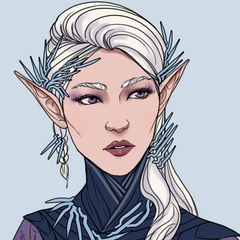 | |
| Nation State | Life and Death Isldar States |
| Ruler | Tower Councils |
| Other Present | Varied |
| Languages | Altalar |
| Religion | Varied |
| First Recorded | 100 BC |
| Demonym(s) | Isldar |
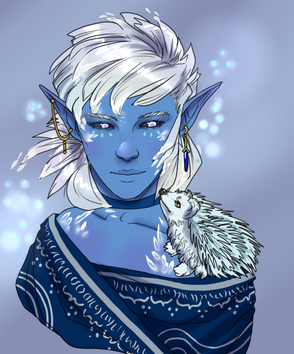
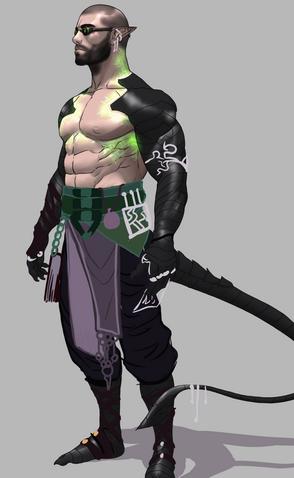
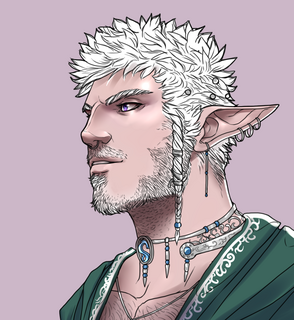
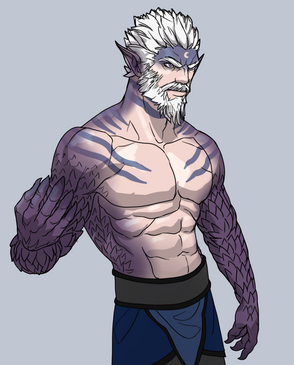
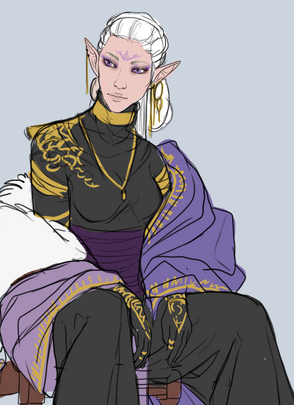
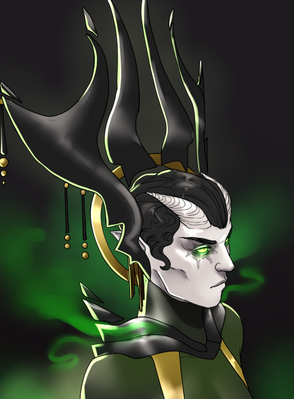
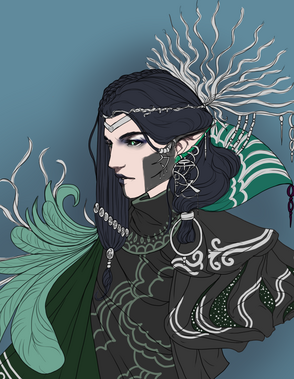
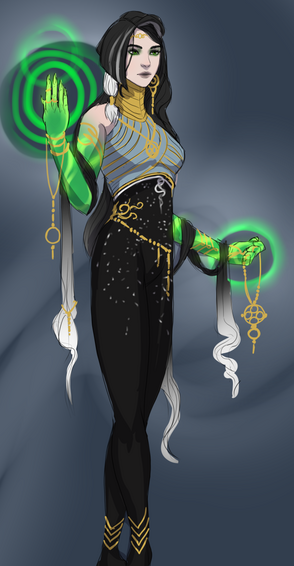
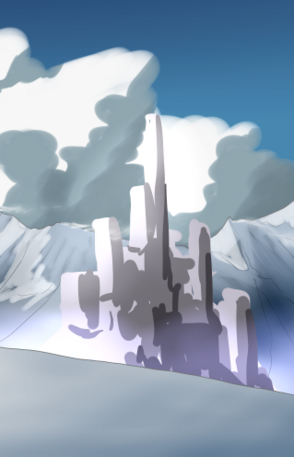
Silent watchers of the frozen mountain peaks, the Isldar are a Race of Snow-Elves who dwell in the distant continent of Ellador and guard its endless, icy valleys. With humble origins as a minor religious cult in the Allorn Empire of old, the struggle of their history drove the Isldar to eventually become their own people and their own nation. Seen as mysterious, reclusive, and barely understood by the outside world, the Isldar are often travelers from their home in one of Aloria’s few remaining unexplored corners. In recent years their society has been cruelly divided by a religious schism that has boiled into war, and with the road to peace impossible to see, the Life and Death Isldar - now bitter enemies - both pray that they will one day triumph. Though they appear in many of the world’s courts as precious advisors and historians, home and family are always close to an Isldar’s heart, for the roads of all their choices eventually lead back to the glimmering spires of Ellador.
Design
The Isldar are patient and prudent Snow Elves, taught from birth to keep their feelings and intentions closely guarded. They are die-hard stoics, sometimes seen by others as emotionless for their disdain of vulnerability and the absent coldness written on their faces: much like their homeland, Ellador, which is cast into a perilous and permanent winter. Most Isldar are incredibly religious, with a schism down the middle based on if the Isldar worships Dragons (and is considered a Life Isldar, "Vixit" in their language) or worships the ice Goddess called the Glacial (and is considered a Death Isldar, "Rexit" in their language). They have a deep, sincere, and poetic culture which struggles with any sort of crudeness or sarcasm. The Isldar are just as famous for their beautiful verses as for their inability to laugh at jokes or smile. Physically, Isldar can have any body shape, but tend towards sharp, narrow facial features and angular frames, often lacking the broadness more common in Human descent. They tend to be tall, with an average height around six foot. Isldar usually style themselves in a traditional Elven way, with robes and long hair.
- Eye Colors: Isldar eyes must be purple if Life Isldar, green if Death Isldar, and blue if Neutral Isldar. Their sclera can be either white or black.
- Hair Colors: Isldar have very desaturated natural hair colors. Any white, black, or gray tone, or a pale tone like platinum or strawberry blonde, occurs naturally.
- Appearance: Isldar are mostly pale, but sometimes have a northern tan (see real life Inuit or Tibetans for examples). They can have any Caucasian or Asian features.
- Patron Traits: Life Isldar can have Dragonscale patches on their bodies, and Death Isldar can have black metal Dragonscale-like patches on their bodies.
Isldar in Regalia
A century ago, Isldar were so rare that they were frequently confused for the more numerous Elven races. Nowadays, however, the schism and civil war in Ellador has led to a massive departure of Isldar from their homeland. Though there are more in some places than others, there are now enough Isldar abroad that most people have heard of them and their culture, with little pockets scattered around the known world. Here are some concepts for player use:
- The Life and Death Isldar are currently under a truce. Some members of both factions have taken advantage of this to come to Regalia to lobby for the homeland.
- The Life Isldar have a refugee colony in Anglia under the high priestess of the Dragon Regulus, who frequently sends her people to Regalia.
- The Death Isldar understand that there is no better place to cause death than Regalia, the center of the world. It is an excellent place for their work.
- Isldar are famous musicians, poets and court performers. Irrespective of their side in the war, some of them come to Regalia just to perform.
Heritage Traits
Heritage Traits are free Packs and Mechanics. Free Packs never raise Proficiency Points, just giving the Pack, and obey lock-outs (if something would prevent you from buying the normal version of the Pack, you can't have the free Pack, either). A Character born from two parents with different Traits get the free Packs of one parent, but can mix and match from both parents' Mechanics. Isldar get their two general Mechanics, plus three more depending on what subtype of Isldar they are: Life, Death, or Neutral.
Free Packs
- Isldar can choose one Athletic or Magic Pack for free.
- Isldar can choose one pack from Roguery Point Buy for free.
Mechanics
All Isldar Mechanics
- Isldar are immune to harm from frost or cold sources (unless they are Magical), and do not suffer decreased visibility or choking hazard in a blizzard/snow-storm.
- Isldar can see things from incredibly far away if they focus, able to spot an eagle landing a kilometer away or a coin being flipped across a town. Ask DM for Event use.
Life Isldar Only Mechanics
- Life Isldar can perform the Life Song on a recently deceased person of any heritage or culture, ensuring they pass into the afterlife (with OOC consent).
- Life Isldar can use Farsight to receive vague visions of things happening and existing in faraway lands. (this may require communication with Event DM's or Tickets).
- Life Isldar can see the Soul Rivers of Aloria where the dead pass through, and are able to tap into it, to feel random memories, emotions, or feelings from long ago.
Death Isldar Only Mechanics
- Death Isldar can perform the Death Song on a recently deceased person of any heritage or culture, forcibly turning them into an Undead (with OOC Consent).
- Death Isldar can steal non-Player Spirits from other Characters, and force them to be servants. They can only be taken back if the Death Isldar is KO'd.
- Death Isldar can Transform into the Bone Horror Shift, a hulking monster made of bones and rotting flesh, which counts as a Disguise but is obviously a Death Isldar.
Neutral Isldar Only Mechanics
Life and Death
The Isldar descend from a cult of Dragon Worshipers, forced to flee from the Elven Empire they lived in for religious heresy. After a Magical event bathed their new homeland of Ellador in frost and killed the armies sent to hunt them down, they settled down in isolation, not knowing that their Dragon patron had been replaced, her body possessed by a great Demon of a Death God. Recently, other Dragons returned and exposed the Death God's scheme, resurrecting the true Dragon and sending Isldar society into a spiral. This pitted the city people (who stayed loyal to the Death God who had saved them, even if they had lied) against the rural tower people from the spire observatories (who took up the cause of Dragons again and started a rebellion), creating the division between Death and Life Isldar. The Life Isldar would have lost and been driven off or killed if not for the Regalian Empire's intervention, which was enough to bring the two sides to a truce and allow them to focus on fighting off the dark Vampire kingdom of Dorkarth, which borders both of them.
At the moment of the Death God's exposure, every Isldar was forced to choose between staying loyal to the Death God, the Glacial, or returning to Dragons. A Death Isldar cannot change into a Life Isldar and vice versa, unless they kneel before the patron God of the opposing side (the Glacial or any Dragon, respectively), and admit that they were wrong (spend a God-summoning token for an offscreen conversion). However, if any Isldar converts away from their patron religion or declares that they will have no part in the war, they become a Neutral Isldar instead, and re-gain some of the biology of their Elven ancestors before they became Isldar. A Neutral Isldar cannot go back to either side. It is considered treason for a Life Isldar to associate with a Death Isldar, or a Death Isldar to associate with a Life Isldar, even though they are under a state of truce. Neutral Isldar can be received by both sides, but are sneered down on for cowardice by fanatics, or those who have lost a lot in the war.
Though they share a culture page, Life and Death Isldar are bitter enemies with very different beliefs. The sections below will make it clear what lore refers to what group.
Language and Naming
The Isldar speak the Elven common language Altalar, but have an incredibly strong dialect called Sulvaley. Sort of like a midpoint between Altalar and the Suvial language Agasi, it has much harsher sounds and different word choice in places that makes it very difficult for most other Elves to understand. Though they are still Elves, the accent of the Isldar gives them an almost Arabic feeling when they talk. Sulvaley additionally has a unique script. Though modern Altalar is written with an alphabet, ancient Altalar had characters for syllables. The Isldar held onto this style and write vertically in a flowing hand, making their lettering appear almost similar to real-world Mongolian writing.
- Example Male Isldar Names: Asrel, Henqaan, Nayaal, Novyaan, Anshaar, Ravlan, Marcaror, Sonraal, Narvael, Alrifar.
- Example Female Isldar Names: Samala, Isavaila, Saaliya, Silyana, Fismeya, Savraela, Veana, Naerassa, Eyfa.
- Example Unisex Isldar Names: Sil, Aleyras, Asir, Esmeya, Asamey, Manyaar, Qiaan, Feynral, Savaa, Qirnar.
Like other Elves, Isldar usually have quite a few names. First, middle, last, and sometimes their more important parent's name prefixed by "ul-" to show who they are descended from. Clan names are important to the Isldar, as different Isldar houses were always famous for different crafts and skills. Now that their society has been divided by a civil war, some Clans have been destroyed by the division, but the stable and large ones have stayed together and chosen their path almost unanimously. An Isldar named Novyaan A'sil Lorqaar, the son of Anshaar and from a clan called Meyraal, would be called Novyaan A'sil Lorqaar ul-Anshaar Meyraal. Ticket in the Roleplay Discord if you would like help with naming.
Brief History
Over the course of the Allorn (Elven) Empire’s existence, it imported new ideas from abroad as well as developing its own, creating diversity of opinion and religion in its formerly single-minded population. One of these diversities was Draconism, or the act of showing favor to Dragons, the oldest beings on Aloria. Draconism in the Allorn Empire rallied around the Creation Dragon Aurora, a patron of craftsmen and living things who forged life into the world’s many creatures within her Craters of Creation. It originated when an innocent archaeological society began to dig up Dragon ruins scattered around the Allorn Empire, learning that Elves had worshiped Dragons before the Empire's creation and the arrival of new prophets. Converting one by one, the society soon became the Dragon-worshiping so-called Cult of Dregodar, earning the enmity of the Allorn Empress’ inner court and the over-powerful clerics of the state religion, Estelley.
Persuaded by manipulative advisors and secret Cultists of yet other religions who hated Dragons, an Allorn Empress outlawed the Cult and Dragon Worship around 1000 BC. This ignited a large-scale Dragon worshiper uprising across the Empire. It might have been kept to a local rebellion had the Dregodar not chosen to both aid the Eronidas, Dragon-worshiping Orcs who had invaded the Allorn Empire in its north-west, and rapidly free and then arm all of the Asha slaves they had formerly kept to join their side in the war. These escalations eventually led to the Allorn army being mobilized against the Dregodar, beginning a hopeless war they could not survive. Though the Eronidas won and kept their state, in the end the Dregodar lost and were forced to cross the water to another continent with Aurora in tow, while any Dragon worshipers left in the Allorn Empire had to go into hiding and the Asha they had armed disappeared into the Asha resistance.
They arrived in the lush and vast continent of Ellador, where they would meet the locals, the Dwarves. Though they began on good terms, Allorn ambassadors soon followed the fleeing Cult and manipulated the Dwarves into declaring war on them. A hundred-year series of wars followed in which Allorn Archmages and Dwarven mechanical ingenuity together brought the Cult of Dregodar to its knees. Yet, at the final battle beneath the mountain of Udillin’s Foot, Aurora supposedly cast a great spell in revenge, turning the once green Ellador into a frozen wasteland and slaughtering the Allorn and Dwarven armies where they stood, but transforming her Cult into the Race now known as Isldar. Casting the spell changed her, turning her withered and bloated, Undead in appearance. Unbeknownst to the Isldar, she had fallen to her fear and been possessed by a a great Demon of the Death-God called the Glacial.
Still believing they served Aurora (now visibly turned Undead, and renamed to Frisit), the Isldar took advantage of their newfound immunity to the cold to take control of most of Ellador. Mostly ignoring the Cataclysm which wracked the wider world, the Isldar soon came into conflict with the Vampire state of Dorkarth which came to exist in the north of Ellador, along with parties of Velheim Ailor colonists and Dwarves looking to reclaim lost Holds that had been destroyed by the Glacial’s scheme. Brutal ambushers who could melt into the snows and reappear at any moment, the Isldar acquired a fearful reputation, becoming hated by the rest of Ellador’s people over centuries of war. This would continue until very recently, when two powerful Dragons appeared above the Isldar capital and slew Frisit where she stood, revealing the Glacial’s trickery and reviving the true Aurora, who immediately left the Isldar to return to one of her Craters of Creation instead.
Since then, Ellador has been wracked not just by war between the Isldar and their Dorkarthi, Velheim, and Dwarven enemies, but also between the pro-Dragon Life Cult rebellion and the pro-Glacial Death Cult regime. The Velheim and Dwarves, as well as the Regalian Empire, have grudgingly decided to forgive and side with the Cult of Life, shipping Urlan shock troopers to Ellador to help them fight off the Death Cult. This worked well enough that the Death Cult was forced to accept a truce with the Life Cult, and turn to fight Dorkarth together for the time being. Both of them would like to re-ignite the war, but cannot do it so long as Dorkarth poses a mortal threat.
Conflicts & Alliances
A lot of MassiveCraft's lore is constructed around religious, historical, or societal grievances. This section sets out conflict and alliance points for the Isldar.
- Allorn Elves: Most Isldar hate Allorn Elves, considering their Empire a tyrant state of debauchery. Confusing an Isldar for a Teledden will start a fight.
- Asha: The Dregodar freed and armed an immense number of Asha slaves, not because they wanted to, but because they had to. The resultant feelings are complex.
- Eronidas: The Life Isldar remember how much the Dregodar did for the Eronidas, but the Eronidas do not remember or care at all, which saddens them a bit.
- Urlan: As the Urlan show veneration to Dragons, and even aggressive Ellador Urlan still cooperate with the Life Isldar, they are friendly.
- Velheim, Dwarves: Isldar have a long history of war with the Velheim, who usually do not trust them. However, there are cases of Isldar converting to Fornoss and integrating.
- Vampires: Isldar despise Vampires, since they are locked in war with the Vampire state of Dorkarth in western Ellador with its nightmare legions and flying castles.
- Each Other: The main conflict focus of the Isldar is the civil war. They are at once the same people, and one another's most bitter enemies in every meaningful way.
Religions
- Draconism: All Life Isldar by default must worship Draconism to be considered Life Isldar. They usually favor Aurora, but are found in every Dragon circle: Regulus and Caius both have important Isldar servants.
- Evolism: All Death Isldar by default must worship the Glacial, part of the broader Evolist pantheon, to be considered Death Isldar. They prioritize her over the others, but still give favors where they can.
- Fornoss: Some Isldar, both Life and Death, turn to Neutral Isldar by converting to Fornoss and living with the Velheim or Dwarves. There are not that many, but the number is not unnotable, especially in Hedryll.
- Baskarr, Estelley, Unionism: There are few Isldar who worship any of these religions, because Baskarr is a homogeneous Asha ethno-religion, Estelley is the religion of the Allorn oppressors that they suffered for converting away from, and Unionism is simply very foreign, far away, and very alien to the Isldar historical narrative. Some Isldar convert away to these religions and become Neutral, but need strong justification.
Until Evolism is updated to include the Glacial, a basic version of Glacial dogma will be included here. The Glacial is an Isldar Archmage who lived during the war against the Allorn Empire, though it isn't specified when. In desperation to save her people, she delved into forbidden tomes of Magic and accidentally trapped herself within the Death Realm, gaining enough power and Ordial Magic over time until she could reach into the world of the living through Avatars and Spirits as a Death God, though it isn't clear how. The Death Isldar understand that when they ritualistically kill in the name of the Glacial, the souls are sent on to her power in the Death Realm. They believe that if she amasses enough power, she will destroy the Malefica who traditionally rules there, usurp the Dimension, and burst into Aloria to create an Undying Paradise and Empire for the Death Isldar where they languish in her love without suffering, interference, or interruption, from anyone who would seek to attack them, ever again. It is a very Undead- and Spirit- happy religion that encourages the mass use of both of these things as bound legions to wage wars for the Death Isldar, and cultivates powerful and corrupt Ordial Mages as its priesthood. Since its dogma effectively demands that people be murdered to increase the power of its God, most people are not happy to see a Glacial worshiper, but the Death Isldar like to say that "there was always going to be a death, only, it does not have to be you." When the Isldar split into Life and Death Isldar, for the Death Isldar Frisit worship immediately stopped being fake Dragon Worship and started being full-blown Death cultist Magic. Those of them who were not Ordial Mages before have definitely become so now, and their clothes and styling have started taking on otherworldly, malevolent appearances to style after their master's servants'.
Isldar Civil War
The Isldar Civil War is so immensely important that it deserves its own section. Before the Civil War, the Isldar were ruled by an entity that called itself Frisit, the Undead Frost Dragon. Frisit was really a Demon of the Death God called the Glacial in a Dragon's body, but was pretending very carefully to be a genuine Dragon, and so operated for the most part within the bounds of Dragon Worship. Other than being oddly Death-obsessed and fighting in the wars across Ellador, the Isldar did not have an unusual society for Dragon Worshipers. Magic was relatively rare but still present and un-persecuted since Aurora lacked other Dragons' zeal for their war against Magic, with just a few Dragon-empowered Archon born from older lineages that dated back to Aurora's actual lifetime scattered through the library towers in the countryside. Although the Death Isldar in the modern day are fierce necromancers and Death Magic spellcasters who fight with legions of the damned, this is an incredibly modern change that only happened once the Glacial was clearly revealed. Even though they are zealous enemies of Dragons and Dragon Worship, the Death Isldar were basically raised Dragon Worshipers of Frisit until the schism, with their expression of belief only changing as the visible nature of their Goddess did. That the Glacial's deceit could not be discovered for so long was not due to the absence of other Dragons, or supposed naive behavior on the part of the Isldar, but because the Demon Frisit was very, very good at pretending to be a Dragon, and did nothing to betray that belief until she was exposed.
Almost all Death Isldar come from the gigantic Isldar moon spire metropole cities built atop the mountains, and almost all Life Isldar come from the rural observatory towers and shacks scattered out in the middle of nowhere. The Isldar Civil War has as much of an economic motivation as a religious one, although the Isldar consider any suggestion to that effect a crude form of insult, and would gladly start a fight over it. The fact is, however, that the more powerful Isldar clans in the cities had a lot of political power because of their closeness to the priesthood of Frisit. Joining the Life Isldar rebellion would have meant giving that all up to live in caves and fight on the run against overwhelming force, on behalf of Dragons they had never met, dying for a cause they were not even sure if they believed in anymore. As such, a sizeable majority of the Isldar population (70-30) belongs to the Death Isldar, even if the Regalian popular imagination would depict it the other way around. The Life Isldar, meanwhile, number so strongly from the spire record-keeping towers and empty provinces because these lineages were settled well before the Battle at Udillin's Foot and the end of the War, having been so socially isolated that the entire transformation of Aurora into Frisit went completely over their heads, and their oral and written custom preserved direct proper Dragon Worship as held before without interference.
If the Life Isldar were to win, it would be their goal to achieve the old ideal from when the Isldar first set out to Ellador. The mountaintops to the Isldar, the mountain depths to the Dwarves, and the valleys to be split between the Urlan and Ailor humans depending on historical custom. If the Death Isldar were to win, they would likely turn any remaining non-Isldar prisoners into Shades or Undead and kill, convert, or expel the Life Isldar, then ruling Ellador as an Empire in the Glacial's image until the day of her prophesied return to greet her worshipers in the world of the living. The Death Isldar like to say that the Life Isldar are complacent cowards who are destroying their own nation with treachery for the sake of Gods who do not care about them and never will, and the Life Isldar like to say that the Death Isldar are mindless agents of a cruel, murderous Death Beast who would drown the world for the sake of their own petty selfishness. Even though the Death Isldar are discriminated in Regalia and the Life Isldar are not, both sides have a point to be made. The Glacial did protect and empower the Isldar for centuries, at the same time as she is a Death God, and her followers are murderers.
Culture
Families and Romance
Family is incredibly important to the Isldar, whose broader society remains somewhat tribal, strung together by clans. When living in a place as large and inhospitable as Ellador, clans become an easy way to establish relations with someone else: with each clan usually having a trade, a social standing, and a vague place of origin, just learning a name can communicate a lot of information. Unlike the other Elven peoples who keep very small and slow to grow families, Isldar often have many siblings, first cousins, and even more second cousins. While there is not a pre-written list of Isldar families or great clans, it is encouraged for players to think about their Characters' and use them for easy backstory ties with one another. While some Isldar families and traditional clan bonds were destroyed by the religious schism, the more powerful or stable clans were mostly able to stick together. A situation where an entire great clan of thousands of people went Vixit or Rexit together and a situation where a family of four split halfway down the middle are equally possible, depending on the desired story. The Isldar have a very deep but slightly prudish culture around romance. While they are not as conservative as the Lanlath, for example, the usual ideal demands long sheafs of sappy poetry penned in the honor of one's lover. Another common cultural theme is to sacrifice for love: there are many heroes in the Isldar poems and epics, who were forced to lay down their lives for a spouse or forbidden lover, immortalized after death. Needless to say, the Isldar make for very passionate partners under their frigid, emotionless exteriors, if one is able to survive their love for the dramatic and the occasional moonlight saber duel fought with a competitor for a darling's hand.
Clothing
Isldar fashion is more pragmatic than most Elven styles, made for Ellador's sub-zero environment. It tends to mix a combination of tighter, simpler underclothes with traditional Elven robes that can be quickly shed if a fight breaks out. While the Isldar still wear embroidery and jewelry, they are considered more on the austere side, with muted dulled colors. Isldar inside wear and underclothes tend to be darker and more vivid, while the opposite is true of their cloaks and shrouds, which are overwhelmingly plain, designed with the empty white tundra of Ellador in mind. Moon symbolism is very common with the Isldar because the pale moon was one of the first emblems of the Cult of Dregodar back in the Allorn days, but the Rexit have mostly discarded this and other traditional Elven symbolism for a macabre focus on bone motifs. Dark skeletal mock armor, black metal plates arranged like scales, giant nails and elaborate headdresses: the Rexit have a head for the ostentatious and sleek, dressing to draw eyes from every room they walk into. The Vixit, meanwhile, have a persistent sort of "ranger" look about them due to their origin in the rural provinces. With belts for field equipment and hidden knives, even their upper class, such as it is, looks ready for a week lost in the snow-covered wilderness. There are a few unique Isldar fabrics, such as Starshimmer fabric that looks like a thin translucent dark purple gauze with white star speckles across its surface, that are quite prized and hard to get in Regalia. Additionally, Isldar are skillful tattoo artists: many show religious devotion, while some others are just stylistic. Most Isldar, at least, have Magical glyphs tattooed at the base of their necks in honor of their patron Gods, that are supposed to ward away the eyes of those who would want to harm them.
Art
The Isldar are famous for two forms of visual art: calligraphy, and wall carvings. Their intricate and alien etched designs laid into the permafrost of the deepest Hold interiors can spiral up around the viewer for so high and long that they cannot see the end of them from the ground. Isldar wall carvings are usually renditions of the poetic epics to put them into memory, or more relevantly, religious texts. Many of the countryside Isldar who would later become the Vixit built their crystal towers of observation atop old obelisks and hidden chambers of the gospel of Dragons from the Allorn day. Though some have been destroyed, most yet remain. Isldar calligraphy is prized mostly because of their unique flowing script. While still decidedly Elven, other Elves like to use it in artwork from time to time to make text illegible to the common eye or evoke the distant air of snowy Ellador, while non-Elven cultures see beauty in the twisting, looping shapes, much the same. Otherwise, their poetry and choral song are prized for their intensity, especially the romances. Isldar poetry is often very tragic, dreary, and emotionally heavy: they believe that an honest story must include lows as deep as the highs are tall. Even the Isldar Song of Life and Song of Death, the magical cants that pass the dead on or damn them to Undeath, have been described as a love song to a life and a hate song to a death respectively, begging the listener in swirling verse to accept the beauty of the time they have had, or rage against what was taken from them.
Other Cultural Habits
- Isldar cannot stand spicy food, but they have the inverse: very, very strong minty substances that can get so strong as to numb the mouths of those without appropriate tolerance. A common Isldar response to being made fun of for not being able to handle a pepper is offering the offender a sprig of Ellador Blizzardmint.
- Isldar have a very strong tea culture. It is a critical element of any and all Isldar hospitality to offer a guest some tea. Some Isldar even barter with tea bricks. Most famous of all is their black tea steeped for a very long time to be incredibly strong, and then muddled with butter from Ellador mountain yaks, so that it has a buttery and warming feeling to it.
- Isldar alcohol is very sweet and fruity, with bright peach and pear and apple notes. They drink it in shots served in engraved steel cups inlaid with silver. Sometimes Isldar alcohol is flavored with the mint mentioned in the previous bullet point, which gives it a chilling kick in the back of the throat.
- Isldar are Wyvern riders, both Vixit and Rexit, and fancied to be the best in Aloria. Even though they are excellent riders who form lifetime bonds with their mounts, there is an Isldar saying that "only a southlander would fly a wyvern for everyone to see." Just like one can be ambushed on the land, one can also be ambushed in the sky by those who take offense to one's presence.
- Isldar are not just singers. They also have a long tradition of harp and lyre music, and very deep, wistful flutes carved from the reeds that used to grow on the banks of southern Ellador before it froze over. All the same, it is their choirs that remain the most famous both at home and abroad, usually as a medium for their poetic tradition.
- Isldar enjoy accuracy-based sports like rifle, archery, javelin, and dart competitions with the best shot being rewarded. These take precedence over any kind of organized team sports. On the intellectual side, they are also fond of symposiums, debates, and other kinds of verbal sparring. Anything with a duel theme is bound to be popular.
- Isldar have a very strong concept of guest right and hospitality. If one is enemies with an Isldar, the safest place to be is at their doorstep begging sanctuary. The most common way guest right is given is by offering a glass of ice water. If an Isldar offers one among five captives a drink, then that one should breathe easy, and the other four should start sweating.
- Isldar prize their ornamented, inscribed dueling sabers, which are passed down their family line as an object of honor and dignity. These swords are only intended to be ceremonially used for honor duels, and are so richly decorated that they would not long survive the beating that a tour of use on the battlefield would mark on them.
- Isldar camping and woodcutting blades are short, curved forward at the tip (refer to real-life Nepalese khukuri). In a pinch, it can be a useful sidearm.
- Isldar are one of the cultures of Aloria that sometimes uses gunpowder weapons. They have no native gunpowder artillery, or sidearms like pistols, but make very long metal-banded rifles they call 'jazalya,' for sniping into valleys.
- Isldar do not see honor in standing and fighting. They are relentless ambush warriors who attack their enemies unseen, cover them in a hail of javelin fire, dive in with their moon-glaives, and then turn around and escape back onto their Wyverns and leave. The Isldar saying on this goes, "the men who call you cowards will die."
- Isldar love hunting and wilderness pursuits. They are stealthy and silent hunters, the calculated and chilling opposite of the nature-attuned Urlan. If Isldar and Urlan are hunting together, it is doom for their target.
- Isldar also love parkour and roof climbing and running in urban settings. Rooftops also make space to sit privately and talk about personal feelings without a looming crowd, making them an Isldar favorite.
- Isldar are very adept observers and astronomers, especially with their brilliant eyesight. Their Crystal Spire observatories hidden around Aloria also double as places to chart the stars.
- Isldar are fond of moon and lunar symbolism. In the early days, the Dragon Worshipers disguised themselves as worshipers of Leyon by using a slightly different moon, and this stuck.
Recommended Playstyle
The Recommended Playstyle section explains some easy-to-enter niches that these people of Aloria function well in.
- Isldar Rangers are some of the best in the world, investing in Ranger Point Buy or Deadeye Point Buy.
- Isldar Adventurers are quick on their feet and good with knives, investing in Cutthroat Point Buy.
- Isldar Lifesingers are the talented Archon healer clerics and sages, investing in Magic Point Buy and Cleric Point Buy as Archon.
- Isldar Deathsingers are the powerful and corrupt Death Priests of the Glacial, investing in Magic Point Buy, sometimes as Geists.
- Isldar Glaive Ambushers are the larger and stronger frontline troops, investing in Bruiser Point Buy and Magic Point Buy.
Trivia
- The Isldar like to play checkers. Not because it is considered mentally challenging, but because the white pieces are a metaphor for the Life Isldar and the black pieces are a metaphor for the Death Isldar.
- The elaborate acrobatic games of the Isldar, like throwing darts and backflipping, have achieved some renown around the world as evidence of the unrivaled dexterity of these mysterious Snow Elves.
- Now that the Glacial does not rule all of Ellador, some parts of the continent in the south near the coast are defrosting and turning green again, albeit very, very slowly, valley by valley.
| ||||||||||||||||||||||||||
| Accreditation | |||||||
|---|---|---|---|---|---|---|---|
|
| ||||||